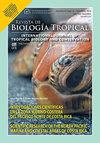解开更多谜团:关于中美洲和加勒比海的bredanensis(偶蹄目:海豚科)遗传多样性和种群结构的新信息
IF 0.6
4区 生物学
Q4 BIOLOGY
引用次数: 0
摘要
简介:粗齿海豚(Steno bredanensis)生活在热带纬度的海洋水域,在一些海洋岛屿上表现出亲缘关系。然而,该物种在少数地区的浅海沿岸水域被观察到。特别是在中美洲,粗齿海豚偶尔会被记录和搁浅。例如,2012年7月17日,在巴拿马加勒比海的一个沿海地区,在对宽吻海豚的监测调查中,首次确认了该物种的记录。同样,2016年4月20日,巴拿马太平洋第一次报道了粗齿海豚大规模搁浅,在Ostional海滩,60只海豚搁浅,10只死亡。这些目击和事件为获取样本进行遗传研究提供了宝贵的机会,这在该地区是稀缺的。目的:在本研究中,我们首次基于线粒体DNA控制区(mtDNA-CR)对巴拿马太平洋和大加勒比地区粗齿海豚的遗传多样性进行了评估。方法:在哥伦比亚(N=5)、巴拿马(N-加勒比=1,N-太平洋=9)和波多黎各(N=3)从散养和滞留个体中采集样本。从每个样品中提取DNA,通过PCR扩增出约534 ~ 748 bp的mtDNA片段。获得的序列与先前在NCBI上发表的粗齿海豚单倍型(N=70)进行了比较,这些粗齿海豚来自大西洋、印度洋和太平洋。结果:各洋盆间种群结构显著(与ΦST数据有较强的分化),各系群间具有较高的遗传多样性。只有大西洋在盆地内表现出高度的遗传分化,发现了三个系统群:加勒比海、北大西洋和南大西洋。结论:这些发现支持了先前的遗传学研究,表明海洋盆地中存在高水平的种群结构,尽管该物种似乎分布广泛。然而,来自巴拿马和加勒比地区的样本似乎显示了高度分化的大西洋和太平洋之间的连通性。因此,我们的研究结果强调需要进行更多的研究来评估中美洲粗齿海豚的遗传和种群状况,作为澄清其在世界范围内的分类和遗传分化所需的拼图的一部分。由于世界自然保护联盟将粗齿海豚列为“最不受关注”的物种,并根据CITES将其列入附录II,因此需要这些信息。虽然个体可能受到偶然捕捞的威胁,但目前没有管理单位来保护该物种,尽管它具有高度的遗传分化。本文章由计算机程序翻译,如有差异,请以英文原文为准。
More pieces for the puzzle: novel information on the genetic diversity and population structure of Steno bredanensis (Artiodactyla: Delphinidae) in Central America and the Caribbean Sea
Introduction: The rough-toothed dolphin (Steno bredanensis) inhabits oceanic waters of tropical latitudes and exhibits philopatry in some oceanic islands. However, the species has been observed in shallow coastal waters in a few areas. Particularly in Central America, the rough-toothed dolphin has been reported by occasional records and strandings. For instance, the first confirmed record of this species in the Panama’s Caribbean was on July 17, 2012, in a coastal region of the Chiriquí Lagoon during a bottlenose dolphin monitoring survey. Similarly, the first rough-toothed dolphin mass stranding reported for the Pacific of Panama was on April 20, 2016, at the Ostional Beach, where 60 dolphins stranded and ten died. These sightings and events offered a valuable opportunity to obtain samples to conduct genetic studies, which are scarce in the region.
Objective: In this study, we present the first assessment of genetic diversity for rough-toothed dolphins based on mitochondrial DNA Control Region (mtDNA-CR) in the Panamanian Pacific and the Wider Caribbean.
Methods: Samples were collected in Colombia (N=5), Panama (N-Caribbean=1, N-Pacific=9), and Puerto Rico (N=3) from free-ranging and stranded individuals. DNA was extracted from each sample, and a mtDNA segment of around 534 to 748 bp was amplified through the PCR reaction. The obtained sequences were compared with rough-toothed dolphin haplotypes previously published in NCBI (N=70), from the Atlantic, Indian, and the Pacific Oceans.
Results: Our findings showed significant population structure among ocean basins (strong differentiation with ΦST data), and high genetic diversity within each phylogroup. Only the Atlantic Ocean showed high genetic differentiation within the basin, detecting three phylogroups: the Caribbean, northern, and southern Atlantic.
Conclusions: These findings support previous genetic studies that indicate high levels of population structure among ocean basins, although this species seems to be widely dispersed. However, samples from Panama and the Caribbean appear to show connectivity between highly differentiated Atlantic and Pacific Oceans. Therefore, our results highlight the need for more research to assess the rough-toothed dolphin genetic and population status in Central America, as the piece of the puzzle needed to clarify its taxonomy and genetic differentiation worldwide. This information is needed due to the rough-toothed dolphin IUCN categorization as “Least Concern” and its classification into appendix II according to CITES. While individuals are potentially threatened by incidental fishing, no management units are currently used to conserve this species despite its high genetic differentiation.
求助全文
通过发布文献求助,成功后即可免费获取论文全文。
去求助
来源期刊

Revista De Biologia Tropical
生物-生物学
CiteScore
1.80
自引率
0.00%
发文量
23
审稿时长
4-8 weeks
期刊介绍:
The Revista de Biología Tropical / International Journal of Tropical Biology and Conservation is a mainstream scientific journal published since 1953 and covered by Web of Science; Science Citation Index; Current Contents; Google Scholar; Scopus, SciELO and nearly 50 additional indices.
A double blind system guarantees you a fair evaluation, and our world class editorial and scientific boards provides a first decision in three working days. The journal is Full Open Access and is widely read where your article can have the highest real impact.
Since its beginning in 1953, the Revista follows these principles: objective and independent evaluation of all manuscripts; transparency in all processes; ethical use of procedures, data, specimens and subjects; fair treatment of all parties; and absolute predominance of scientific rigor over any other aspect.
 求助内容:
求助内容: 应助结果提醒方式:
应助结果提醒方式:


